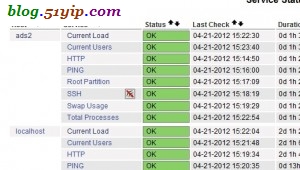nagios 多服务器监控 服务端与客户端 配置

nagios可以一台机器监控多台服务器,客户端可以是linux,也可以是windows服务器。我现在nagios的监控是这样的。nagios服务端和邮件服务器放在一起,剩下的服务器都装一下nagios的客户端,这样我就可以在服务端的web界面里,看到所有服务器状况,并且还有邮件报警。
服务端ip地址:192.168.1.122
客户端ip地址:192.168.1.120
一,服务端安装nagios-plugins-nrpe
[root@localhost nagios]# ll /usr/lib64/nagios/plugins/ |grep nrpe -rwxr-xr-x 1 root root 21840 10月 25 2010 check_nrpe //如果没有显示上面的内容,说明你没有安装 //安装check_nrpe [root@localhost nagios]# yum install nagios-plugins-nrpe
在这里只是提到了,多服务器监控所要的软件,如果要从头开始来安装nagios,请参考前面几篇博客
二,客户端要安装nrpe
[root@localhost nagios]# yum install nagios-plugin nagios nrpe fcgi-devel fcgi nagios-plugins-all
开始我以为在客户端上安装nrpe就行了,但是不对,这根munin不一样,思维定式啊。客户端不要安装web环境。
三,服务端配置
[root@localhost objects]# cp /etc/nagios/objects/localhost.cfg /etc/nagios/objects/192.168.1.120.cfg [root@localhost objects]# vim /etc/nagios/objects/192.168.1.120.cfg //修改配置文件1 define host{ use linux-server host_name ads2 //把localhost改成你知道是哪台标识 alias ads2 address 192.168.1.120 //被监控服务器的ip,可以是局域网,也可以是共网的 } //把define hostgroup,全注释掉。加上hostgroup,重加载就报错 #define hostgroup{ # hostgroup_name linux-servers # alias linux Servers # members 192.168.1.120 # } //define service有很多以check_disk为例说一下 define service{ use generic-service //local-service改成generic-service host_name ads2 //localhost改成自定义ads2 service_description Root Partition check_command check_nrpe!check_disk!20%!10%!/ } //把上面的check_local_disk改成check_nrpe!check_disk,如果有不带local的,例如:check_ping改成check_nrpe!check_ping [root@localhost objects]# vim /etc/nagios/objects/commands.cfg //修改配置文件2 //添加以下内容 define command{ command_name check_nrpe command_line $USER1$/check_nrpe -H $HOSTADDRESS$ -c $ARG1$ } [root@localhost objects]# vim /etc/nagios/nagios.cfg //修改配置文件3 cfg_file=/etc/nagios/objects/192.168.1.120.cfg //加上这一行。
到此服务器的配置就完成了,重新加载一下nagios。/etc/init.d/nagios reload
四,客户端配置
[root@localhost ~]# vim /etc/nagios/nrpe.cfg allowed_hosts=192.168.1.122,127.0.0.1 //79行,加上服务端的ip,可以是局域网,或者是共网的IP command[check_users]=/usr/lib64/nagios/plugins/check_users -w 5 -c 10 command[check_load]=/usr/lib64/nagios/plugins/check_load -w 15,10,5 -c 30,25,20 command[check_disk]=/usr/lib64/nagios/plugins/check_disk -w 20% -c 10% -p /dev/mapper/VolGroup-lv_root command[check_zombie_procs]=/usr/lib64/nagios/plugins/check_procs -w 5 -c 10 -s Z command[check_procs]=/usr/lib64/nagios/plugins/check_procs -w 150 -c 200 command[check_http]=/usr/lib64/nagios/plugins/check_http -H 127.0.0.1 -w 5 -c 10 command[check_ping]=/usr/lib64/nagios/plugins/check_ping -H 127.0.0.1 -w 3000.0,80% -c 5000.0,100% -p 5 command[check_ssh]=/usr/lib64/nagios/plugins/check_ssh -4 127.0.0.1 command[check_swap]=/usr/lib64/nagios/plugins/check_swap -w 30% -c 10%
在配置过程中遇到以下错误:
1,NRPE: Command 'check_http' not defined
2,NRPE: Command 'check_ssh' not defined
3,NRPE: Command 'check_ping' not defined
4,NRPE: Command 'check_disk' not defined
5,NRPE: Command 'check_swap' not defined
6,NRPE: Command 'check_procs' not defined
解决方法:
就是/etc/nagios/nrpe.cfg里面添加相应的command[]配置,例如解决check_http not defined只要加一个command[check_http]就行了。
以下是我在命令行下的测试,只要命令行下OK了,nagios的web监控就不会报错了。
[root@localhost objects]# /usr/lib64/nagios/plugins/check_nrpe -H 192.168.1.120 -c check_http OK - load average: 1.04, 0.31, 0.10|load1=1.040;15.000;30.000;0; load5=0.310;10.000;25.000;0; load15=0.100;5.000;20.000;0; [root@localhost ~]# /usr/lib64/nagios/plugins/check_nrpe -H 192.168.1.120 -c check_ping PING OK - Packet loss = 0%, RTA = 0.04 ms|rta=0.035000ms;3000.000000;5000.000000;0.000000 pl=0%;80;100;0 [root@localhost ~]# /usr/lib64/nagios/plugins/check_nrpe -H 192.168.1.120 -c check_disk DISK OK - free space: / 41756 MB (87% inode=96%);| /=6080MB;40316;45356;0;50396 [root@localhost ~]# /usr/lib64/nagios/plugins/check_nrpe -H 192.168.1.120 -c check_ssh SSH OK - OpenSSH_5.3 (protocol 2.0) [root@localhost ~]# /usr/lib64/nagios/plugins/check_nrpe -H 192.168.1.120 -c check_swap SWAP OK - 100% free (10047 MB out of 10047 MB) |swap=10047MB;3014;1004;0;10047 [root@localhost ~]# /usr/lib64/nagios/plugins/check_nrpe -H 192.168.1.120 -c check_procs PROCS CRITICAL: 285 processes
客户端配置很简单,重起一下/etc/init.d/nrpe reload
如果使用了iptables等类似防火墙的话,开一个端口5666,你可以通过netstat来查看端口情况。或者是配置文件。

nagios监控多台服务器

